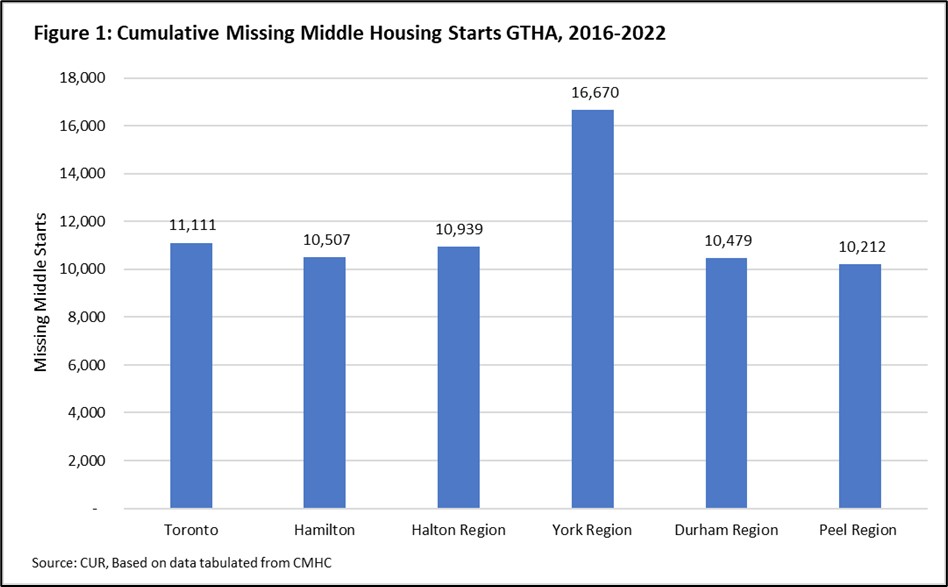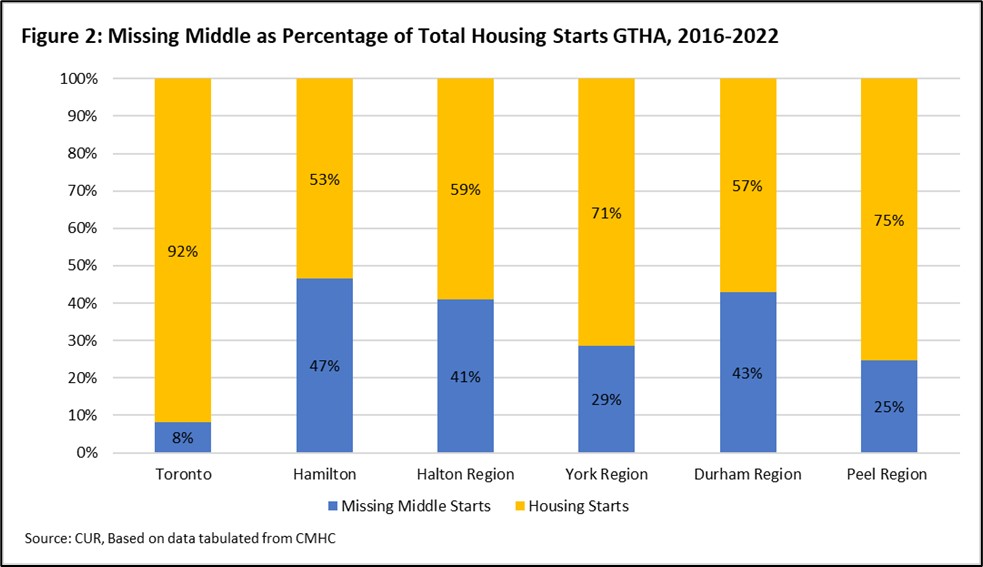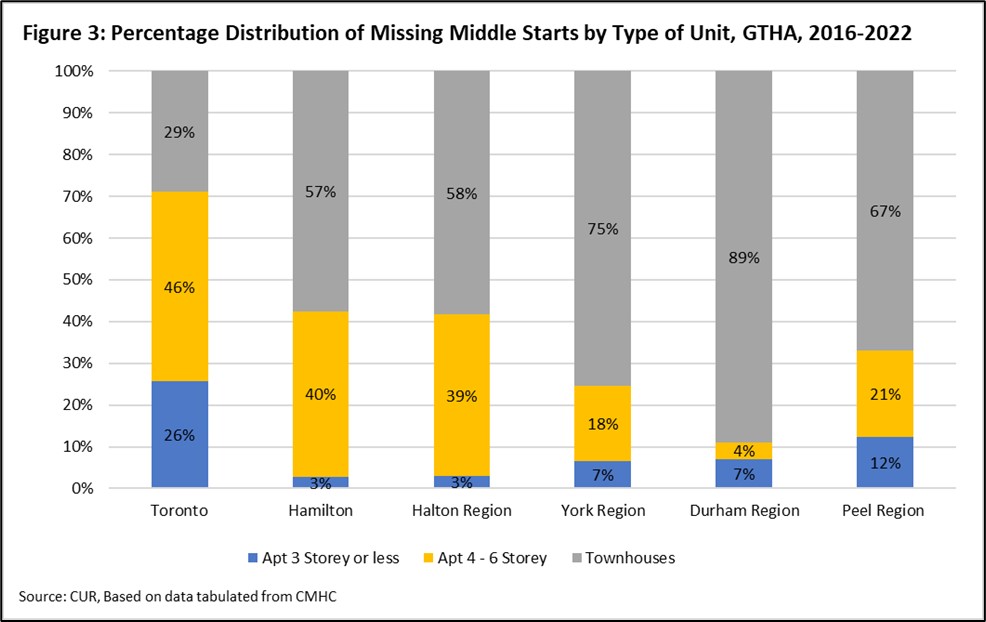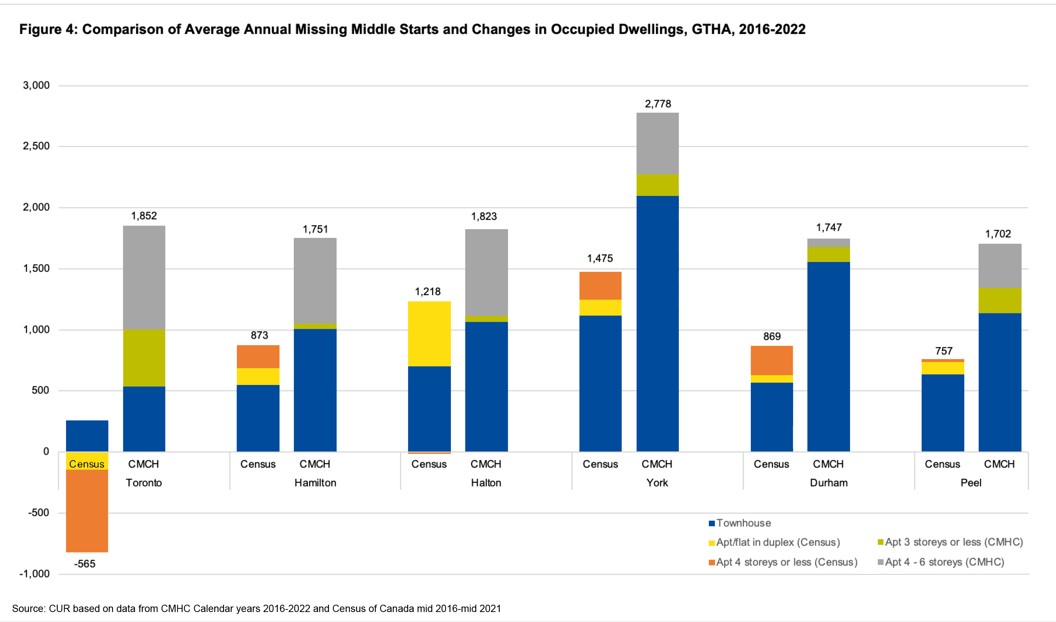Missing Middle Housing Starts in the Greater Toronto and Hamilton Area, 2006-2022
By: Frank Clayton, Senior Research Fellow, and Maaha Nomani, Research Assistant
December 18, 2023
(PDF file) Print-friendly version available
Executive Summary
The paper examines missing middle housing starts in the Greater Toronto and Hamilton Area (GTHA) during the six years from 2016 to 2022. It compares these starts to the net additions to occupied dwellings drawn from Census of Canada data from mid-2016 to mid-2021. Missing-middle housing is approximated by summing the CMHC starts data for three housing types: townhouses, apartments in structures of three storeys or less, and apartments in structures of four to six storeys.
Highlights include:
- York region recorded the most significant number of missing middle starts in the GTHA between 2016-2022.
- Missing middle starts are most prominent in Hamilton, Durham, and Halton – negligible in Toronto.
- The majority of missing middle starts are townhouses in all municipalities except Toronto.
- All GTHA municipalities recorded higher missing middle starts than changes in occupied dwellings, with Toronto recording a decline in its stock of occupied missing middle dwellings between 2016 and 2021.
The bottom line is that more has to be done to protect the stock of existing missing middle housing in GTHA municipalities while at the same time increasing the starts of new missing middle housing of all types and in all locations.
Background
The production of more missing middle housing units is a priority as it has been increasingly regarded as a solution to the affordability housing crunch, particularly within the Greater Toronto Area (GTA) portion of the Greater Golden Horseshoe (GGH)[1]. It is a middle ground for those who oppose singe-detached and semi-detached houses for environmental reasons (e.x., increased emissions and the development of greenfields) and high-rise apartments for quality-of-life reasons. Yet, little monitoring is done of the quantity and types of missing middle housing being built.
CUR recently released a report using data from the Census of Canada to document the size, importance, and trends in the production of missing housing in the Greater Golden Horseshoe and the Greater Toronto Area between 2006 and 2016.[2] The Census of Canada represents the most comprehensive database for missing middle housing. However, these data are only available every five years and with a lag.
This paper compiles and examines missing middle housing utilizing CMHC housing starts data. These data have the advantage of being released each month. However, they cover only additions to the housing stock through newly constructed residential buildings. Excluded are changes within the existing housing stock such as the creation of secondary suites in existing single-detached houses or the losses of missing middle units through demolition or conversion.
The paper examines missing middle housing starts in the Greater Toronto and Hamilton Area (GTHA) during the six years from 2016 to 2022. It compares these starts to the net additions to occupied dwellings drawn from Census of Canada data from mid-2016 to mid-2021.
Missing-middle housing is approximated by CMHC starts data for three housing types: townhouses, apartments in structures of three storeys or less, and apartments in structures of four to six storeys.[3]
The paper includes four tables for the six single-tier and regional municipalities composing the GTHA.[4]
- Total missing middle starts, 2016-2022.
- Missing middle starts as a percentage of total starts, 2016-202
- Missing middle starts by type of unit, 2016-2022.
- A comparison of average annual missing middle starts, 2016-2022, with the average annual change in the stock of missing middle housing 2016-2021 from the Census of Canada.
Missing Middle Starts in the GTHA, 2016-2022
York Region has the largest number of missing middle starts
Figure 1 presents the cumulative missing middle housing starts in the six GTHA municipalities from 2016 to 2022.

Highlights:
- York region has the largest missing middle housing starts, with a total of 16,670 units during the period of 2016-2022.
- Missing middle starts in the other municipalities were similar in volumes, ranging between about 10,200 to 11,100 unit
Missing middle starts most prominent in Hamilton, Durham, and Halton – negligible in Toronto
Figure 2 depicts missing middle housing starts as a percentage of total housing starts for GTHA municipalities during 2016-2022.

Highlights:
- Missing middle starts accounted for a sizable share of total starts in Hamilton, Durham and Halton regions – 41% to 47% between 2016 and 2022.
- In contrast, only 8% of starts in the city of Toronto were missing middle units.
- York and Peel regions were between the two extremes with 29% and 25% of total missing middle starts.
The majority of missing middle starts are townhouses in all municipalities except Toronto
Figure 3 presents missing middle housing starts for GTHA regions by unit type during 2016-2022. The unit types add up to 100%.

Highlights:
- For Hamilton and the four 905 regions, most missing middle starts were townhouses - ranging from 89% in Durham region to 57% in Hamilton.
- In contrast, in Toronto only 29% of missing middle starts over the six years were townhouses and 72% were apartments.
- In all municipalities except Durham region most apartments were in structures with four to six floors.
- Surprisingly, Toronto had the largest percentage of missing middle starts in apartments in three storeys or less at 26%. Stacked townhouses fall under this housing type.
Comparison of CMHC Missing Middle Starts and Change in Missing Middle Occupied Dwellings
This section compares the average annual change in missing middle starts by type 2016-2022 to the average annual change in occupied dwellings by type 2016-2021.[5] It is important to note that the two data series are not identical. The data from the Census of Canada have a broader coverage (e.g., includes suites in duplexes) and encompasses apartments in structures of four storeys or less, not six or less like the starts do. In addition, new housing starts are not picked up in the Census of Canada until the units are completed and occupied.
All GTHA municipalities recorded higher missing middle starts than changes in occupied dwellings – Toronto’s stock of missing middle housing declined
Figure 4 presents the average annual missing middle starts and change in missing middle households for the GTHA’s municipalities since 2016.

Highlights:
- All municipalities had average annual missing middle housing starts considerably higher than their net changes in occupied missing middle dwellings.
- The differential was particularly wide for Toronto, which experienced a decline in its stock of occupied missing middle dwellings.
- Townhouses were the largest component of missing middle housing units added in all municipalities except Toronto.
- Toronto’s decline in its stock of apartment units in low-rise structures (four storeys or less) during 2016-2021 is even more anomalous when considered against a positive low-apartment production (in structures with six and under storeys).
Conclusions
Highlights include:
- York region recorded the most significant number of missing middle starts in the GTHA between 2016-2022.
- Missing middle starts are most prominent in Hamilton, Durham, and Halton – negligible in Toronto.
- The majority of missing middle starts are townhouses in all municipalities except Toronto.
- All GTHA municipalities recorded higher missing middle starts than changes in occupied dwellings, with Toronto recording a decline in its stock of occupied missing middle dwellings between 2016 and 2021.
The bottom line is that more has to be done to protect the stock of existing missing middle housing in GTHA municipalities while at the same time increasing the starts of new missing middle housing of all types and in all locations.
Endnotes
[1] Frank Clayton and Diana Petramala. “A Strategy for Significantly Increasing the Supply of “Missing Middle” Housing in the City of Toronto”. CUR with funding from the Toronto Regional Real Estate Board, February 2019.
[2] Frank Clayton and Nigel Alfonso. What the Census of Canada Tells Us About the Supply of Missing Middle Housing in the Greater Golden Horseshoe. CUR. October 24, 2023.
[3] The apartments include duplexes, triplexes, quadraplexes, and stacked townhouses. Apartment structures with five or six storeys are not typically treated as missing middle units but are included because of the way CMHC splits the apartments by number of storeys.
[4] Cities of Toronto and Hamilton and regions of Halton, York, Durham, and Peel.
[5] The data have been converted to average annual for comparability since the starts are for six years and the Census data are for five years.